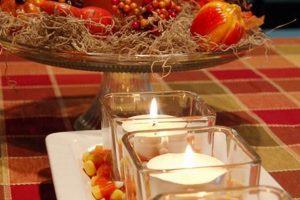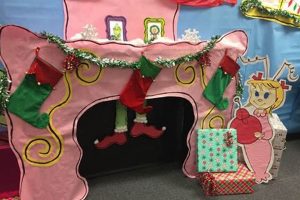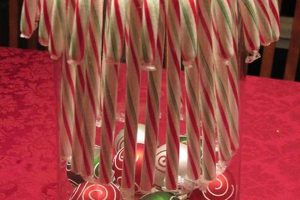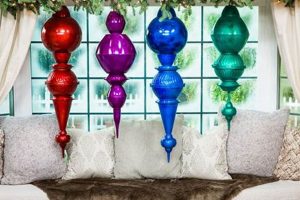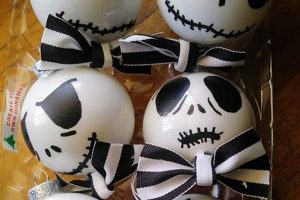Creating customized decorations for an eighties-themed celebration involves crafting elements evocative of the decade using readily available materials and do-it-yourself techniques. Examples include constructing centerpieces from repurposed cassette tapes, designing backdrops featuring geometric patterns reminiscent of arcade games, and assembling balloon arches in neon color schemes.
The benefits of this approach include cost-effectiveness and personalization. Opting for handcrafted embellishments allows for budget management and the opportunity to tailor the aesthetic to specific preferences or memories associated with the era. Historically, the eighties witnessed a surge in creative expression, reflected in the bold designs and vibrant colors that defined its culture. These aesthetic characteristics are reproducible through accessible methods.
The subsequent sections will explore various thematic approaches to homemade decor, provide step-by-step instructions for key decorative elements, and offer guidance on sourcing affordable materials to achieve an authentic eighties ambiance. Considerations for incorporating lighting, music, and interactive elements will also be addressed.
Practical Recommendations for Homemade Eighties-Themed Party Embellishments
The following recommendations are designed to assist in the creation of cost-effective and aesthetically appropriate decor for an eighties-themed event. These tips emphasize resourcefulness and attention to period-specific detail.
Tip 1: Prioritize Neon Color Schemes. The eighties were characterized by vibrant, saturated colors. Employ neon pink, green, yellow, and blue in banners, streamers, and tablecloths to capture the decade’s aesthetic. Obtain inexpensive crepe paper and plastic tablecloths in these hues from discount retailers.
Tip 2: Incorporate Geometric Patterns. Geometric shapes, particularly triangles and zigzags, were prevalent design elements. Construct backdrops from cardboard and paint them with geometric patterns. These can serve as photo opportunities for guests.
Tip 3: Utilize Repurposed Materials. Cassette tapes, vinyl records, and discarded computer parts can be repurposed as decorative items. Cassette tapes can be strung together to create garlands, while vinyl records can be painted and hung as wall art.
Tip 4: Construct a DIY Photo Booth. Create a designated area for photographs using a brightly colored backdrop and props such as oversized sunglasses, Rubik’s Cubes, and inflatable musical instruments. This encourages guest interaction and provides lasting memories.
Tip 5: Employ Balloons Strategically. Balloon arches or clusters in neon colors add visual impact. Consider creating a balloon archway at the entrance to the event space or using balloons to highlight key areas.
Tip 6: Craft Custom Centerpieces. Create centerpieces featuring iconic eighties imagery. Example, a Rubik’s Cube mounted on a pedestal, or a miniature boombox crafted from cardboard.
Tip 7: Illuminate with String Lights. Incorporate string lights with globe-shaped bulbs to create a festive ambiance. Opt for colored bulbs to enhance the eighties theme. These can be purchased affordably and are easy to install.
Implementing these recommendations allows for the creation of a visually compelling and immersive eighties-themed party environment while adhering to budgetary constraints. The key is meticulous attention to detail and resourceful use of readily available materials.
The subsequent section will address common pitfalls to avoid when executing these decorations and offer alternative solutions for achieving the desired aesthetic.
1. Neon Color Palettes
The implementation of neon color palettes is a foundational element in recreating the visual aesthetic of the 1980s for homemade party decorations. The deliberate application of these hues is crucial for achieving an authentic representation of the era’s design sensibilities.
- Color Selection and Application
The selection of specific neon shadesincluding hot pink, electric blue, vibrant green, and fluorescent yellowis paramount. Their application should extend across various decorative elements, such as tablecloths, streamers, balloons, and signage. Effective utilization involves employing these colors in stark contrast with one another to maximize visual impact.
- Material Considerations
Certain materials lend themselves more effectively to displaying neon colors. Plastic, synthetic fabrics, and glossy paper surfaces reflect light in a manner that enhances the vibrancy of the hues. Matte or absorbent materials may diminish the intensity of the colors, thereby reducing the desired effect.
- Integration with Geometric Patterns
Neon color palettes are frequently associated with geometric patterns in eighties design. Triangles, zigzags, and angular shapes, rendered in neon colors, amplify the visual association with the decade. This combination can be strategically employed in backdrops, banners, and wall decorations.
- Lighting Effects
The impact of neon color palettes can be augmented through strategic lighting. Blacklights or ultraviolet (UV) lights intensify the luminosity of neon pigments, creating a glowing effect that further enhances the eighties ambiance. This is particularly effective in dimly lit environments.
The strategic deployment of neon color palettes, considering material properties, integration with geometric patterns, and the use of appropriate lighting, significantly contributes to the success of homemade eighties-themed party decorations. The careful execution of these elements ensures an authentic and visually striking representation of the era.
2. Geometric Visual Patterns
The prevalence of geometric visual patterns constitutes a defining characteristic of eighties design and a significant component of homemade party decorations evoking that era. The adoption of such patterns is not merely stylistic; it directly impacts the perceived authenticity and visual coherence of the decorative scheme. The cause lies in the widespread use of these patterns across various media during the eighties, from fashion and music videos to arcade games and graphic design. This saturation solidified their association with the decade, making their inclusion essential for accurate representation. For example, constructing a backdrop featuring repeating triangles or a zigzag motif immediately signals an eighties theme, contributing to the immersive experience.
Furthermore, the practical application of geometric patterns in homemade embellishments is straightforward and cost-effective. These designs are easily replicated using readily available materials such as paint, cardboard, and tape. A banner constructed from triangles cut from construction paper, or a table runner adorned with a zigzag design painted onto fabric, are simple yet effective ways to integrate this aesthetic. The simplicity of these patterns also allows for variations and personalization without sacrificing the overall theme. Consider replicating the aesthetic of the arcade game “Tron” with neon-outlined geometric shapes on a black backdrop or incorporating the angular designs from the MTV logo into custom signage.
In conclusion, the utilization of geometric visual patterns is a vital aspect of successful eighties-themed party decorations. Their inclusion not only enhances the authenticity of the decor but also provides a relatively simple and inexpensive avenue for customization. While selecting appropriate color palettes and incorporating other thematic elements are equally important, neglecting geometric patterns risks undermining the overall visual impact. Therefore, careful planning and execution of these patterns are crucial for achieving a genuinely evocative eighties atmosphere.
3. Repurposed Material Usage
The incorporation of repurposed materials into eighties-themed party decorations represents a practical and aesthetically relevant approach to event styling. This method aligns with both budgetary considerations and the resourcefulness often associated with do-it-yourself projects, while simultaneously echoing the spirit of creativity prevalent during the 1980s.
- Cassette Tape Integration
Obsolete cassette tapes can be transformed into various decorative elements. Tapes can be strung together to create garlands, serving as a nostalgic backdrop or room divider. Alternatively, tape housings can be disassembled and reconfigured into geometric sculptures or centerpieces, reflecting the angular aesthetic characteristic of eighties design.
- Vinyl Record Repurposing
Unwanted vinyl records offer a versatile medium for crafting thematic decorations. Records can be painted with neon colors and geometric patterns to serve as wall art or table centerpieces. Modification through cutting and shaping enables the creation of three-dimensional forms, such as stylized record players or abstract sculptures reminiscent of eighties album art.
- Electronic Component Reuse
Discarded electronic components, such as circuit boards and computer parts, can be integrated to emulate the technological advancements that defined the era. These components, often exhibiting angular shapes and metallic textures, can be arranged into futuristic installations or incorporated into centerpieces to evoke the technological optimism prevalent in the eighties.
- Cardboard Box Transformations
Cardboard boxes, readily available and easily manipulated, provide a foundation for constructing larger decorative elements. These boxes can be transformed into oversized boomboxes, Rubik’s Cubes, or arcade game cabinets, serving as focal points within the party space. Surface treatment with paint, stencils, and printed graphics enhances the realism and thematic relevance of these repurposed structures.
The strategic use of repurposed materials not only reduces waste and minimizes expenses but also enhances the authenticity and visual impact of eighties-themed party decorations. By creatively transforming discarded items, event organizers can cultivate an immersive and nostalgic atmosphere reflective of the era’s resourcefulness and DIY ethos.
4. Iconic Symbols Incorporation
The inclusion of recognizable icons is paramount in the creation of authentic eighties-themed party decorations. This element serves as a potent visual shorthand, immediately conveying the intended temporal setting and fostering a sense of nostalgia among attendees. These symbols, ingrained in the collective cultural memory, contribute significantly to the immersive atmosphere of the event.
- The Rubik’s Cube as a Decorative Motif
The Rubik’s Cube, a ubiquitous puzzle of the decade, transcends its functional purpose and becomes a readily identifiable symbol of the eighties. Replicas of the cube, either in full-size or miniature form, can be employed as table centerpieces or incorporated into decorative banners. The cube’s bright, primary colors further reinforce the era’s vibrant aesthetic. A large, fabricated Rubik’s Cube can serve as a focal point, instantly signaling the party’s thematic orientation.
- Boomboxes: Auditory and Visual Representations
The boombox, a portable music player synonymous with eighties youth culture, offers a dual sensory experience. Replicas, either purchased or crafted from cardboard, can be strategically placed throughout the venue to evoke the era’s musical landscape. The addition of actual eighties music emanating from these boombox props further enhances the auditory dimension of the theme, solidifying the connection between sight and sound.
- Arcade Game References: Pixelated Nostalgia
Arcade games, a central form of entertainment during the eighties, provide a wealth of visual inspiration. Pixelated representations of iconic characters and game interfaces can be incorporated into banners, backdrops, and even custom-designed invitations. The use of pixel art evokes the technological limitations and aesthetic sensibilities of early computer graphics, adding a layer of authenticity to the decor. Silhouette cutouts of Pac-Man or Space Invaders are readily recognizable and easily reproduced.
- MTV Logo and Musical Artists Imagery
The MTV logo, with its distinctive angular design, represents the rise of music television and its significant influence on popular culture. Replicas of the logo, either printed or fabricated, can be displayed prominently throughout the venue. Additionally, images of popular musical artists from the decade, such as Madonna, Michael Jackson, and Prince, can be incorporated into posters, banners, and even photo booth props, further reinforcing the era’s musical identity.
The strategic integration of these iconic symbols, meticulously chosen and appropriately implemented, elevates the level of detail and authenticity in homemade eighties-themed party decorations. This meticulous approach enhances the overall immersive experience, creating a memorable and engaging event for all attendees. The symbols serve as anchors, grounding the theme in readily recognizable cultural touchstones.
5. DIY Photo Booth Creation
The creation of a do-it-yourself photo booth is a highly relevant and engaging component within the broader scope of eighties-themed party adornments. It provides an interactive element that encourages guest participation and generates lasting mementos of the event. Its success hinges on careful consideration of thematic consistency and resourcefulness, aligning directly with the principles of economical and personalized party decorations.
- Thematic Backdrop Construction
The backdrop of the photo booth serves as the primary visual anchor, establishing the eighties aesthetic. Materials such as neon-colored fabric, geometric patterned sheets, or a custom-painted mural depicting iconic imagery (e.g., a boombox, a Rubik’s Cube, an arcade game scene) are suitable. The backdrop should be large enough to accommodate multiple subjects and visually compelling enough to entice participation.
- Prop Selection and Sourcing
Props are essential for enhancing the interactive nature of the photo booth and reinforcing the thematic elements. Sourcing period-appropriate items, such as oversized sunglasses, fingerless gloves, inflatable instruments, and Rubik’s Cubes, is crucial. Thrift stores, vintage shops, and online marketplaces are valuable resources. Alternatively, props can be crafted from cardboard or foam to replicate iconic eighties objects.
- Lighting and Technical Considerations
Adequate lighting is essential for capturing clear and well-lit photographs. Natural light is preferable; however, in indoor settings, the use of a ring light or strategically placed lamps is recommended. A simple camera setup, such as a smartphone or a digital camera, can be utilized. The inclusion of a remote shutter release or a self-timer function facilitates ease of use for participants.
- Interactive Element Integration
To enhance engagement, consider incorporating interactive elements within the photo booth. A whiteboard or chalkboard allows guests to write personalized messages. The inclusion of a social media hashtag encourages online sharing of the photographs. Providing instant photo printing capabilities further enhances the immediate gratification and tangible nature of the experience.
The successful implementation of a DIY photo booth within the context of eighties-themed party embellishments depends on a cohesive integration of thematic elements, careful resource management, and attention to technical details. The photo booth functions not only as a source of entertainment but also as a visual reinforcement of the party’s overarching theme, contributing significantly to the overall immersive experience.
6. Music-Themed Decor
Music-themed decor constitutes a pivotal element in recreating the atmosphere of the 1980s within the framework of do-it-yourself party decorations. Its significance derives from the profound impact music had on the decade’s culture, fashion, and overall aesthetic. The incorporation of musical motifs serves not merely as decoration, but as a means of evoking a specific cultural context.
- Album Cover Replication
Replicating iconic album covers from the 1980s provides a visually compelling and readily identifiable decorative element. Large-scale printed reproductions of album art, such as those of Michael Jackson’s “Thriller,” Prince’s “Purple Rain,” or Madonna’s “Like a Virgin,” can serve as focal points or backdrops. Alternatively, smaller, handcrafted versions of these covers can be used as table centerpieces or incorporated into wall displays. Accurate reproduction of the album’s font and color scheme is essential for effective communication of the intended thematic reference.
- Musical Instrument Emulation
Emulating musical instruments prominent during the eighties allows for the creation of three-dimensional decorative objects. Replicas of synthesizers, electric guitars, and drum machines can be constructed from cardboard, foam board, or other readily available materials. These models, painted in vibrant colors or adorned with period-appropriate decals, add a tactile and visually engaging element to the party decor. The accurate representation of instrument details, such as knobs, buttons, and strings, enhances the authenticity of the display.
- Cassette Tape and Vinyl Record Integration
The physical media formats of the 1980s, namely cassette tapes and vinyl records, provide a direct and tangible connection to the era’s musical landscape. Cassette tapes can be strung together to create garlands or used to adorn walls. Vinyl records, either painted or left in their original state, can serve as decorative plates or wall hangings. The inclusion of handwritten labels on the cassette tapes, listing popular eighties artists or song titles, adds a personalized and nostalgic touch.
- Music Video-Inspired Backdrops
Recreating scenes from iconic music videos of the 1980s offers a dynamic and visually stimulating decorative approach. Backgrounds reminiscent of music videos by artists such as Duran Duran, A-ha, or Cyndi Lauper can be constructed using fabric, paint, and lighting. The inclusion of props and costumes that mirror those featured in the music videos further enhances the immersive experience. Consideration should be given to the original color palette, set design, and overall aesthetic of the selected music video when creating the backdrop.
The integration of these music-themed decorative elements into do-it-yourself eighties party preparations offers a multifaceted approach to evoking the decade’s cultural landscape. The strategic employment of album cover replications, musical instrument emulations, physical media integration, and music video-inspired backdrops contributes significantly to the creation of an authentic and immersive party atmosphere. These details reinforce the thematic consistency and enhance the overall experience for attendees.
Frequently Asked Questions
The following questions address common inquiries regarding the creation of authentic and cost-effective eighties-themed party decorations utilizing do-it-yourself techniques. These answers provide guidance on material selection, design principles, and practical implementation.
Question 1: What are the essential color palettes for authentic eighties-themed decor?
Authentic eighties decor predominantly features neon and vibrant colors. Primary examples include hot pink, electric blue, fluorescent green, and bright yellow. These colors are often juxtaposed to create high-contrast visual effects. The use of pastel shades, while present in some contexts, should be minimized to maintain thematic accuracy.
Question 2: How can geometric patterns be effectively incorporated into homemade decorations?
Geometric patterns, such as triangles, zigzags, and angular shapes, can be integrated into banners, backdrops, and table coverings. Stencils, paint, and tape are suitable materials for creating these patterns. The patterns should be bold and visually prominent to reflect the design trends of the era.
Question 3: What are some effective methods for repurposing materials in eighties-themed decor?
Cassette tapes, vinyl records, and discarded electronic components can be repurposed as decorative elements. Cassette tapes can be strung together to create garlands, while vinyl records can be painted and displayed as wall art. Discarded circuit boards can be incorporated into futuristic-themed centerpieces.
Question 4: Which iconic symbols are most readily associated with the eighties?
The Rubik’s Cube, boomboxes, arcade game characters (e.g., Pac-Man, Space Invaders), and the MTV logo are readily recognizable symbols of the eighties. These symbols can be incorporated into banners, centerpieces, and photo booth props.
Question 5: What are the key considerations when creating a do-it-yourself photo booth for an eighties-themed party?
The photo booth backdrop should feature a thematically appropriate design, such as a neon-colored pattern or a representation of an arcade game. Props should include oversized sunglasses, inflatable instruments, and other objects associated with the eighties. Adequate lighting is essential for capturing clear photographs.
Question 6: How can music-themed decor be effectively integrated into the party ambiance?
Replicas of iconic album covers can be displayed as wall art or table centerpieces. Models of synthesizers and boomboxes can be constructed from cardboard or foam board. Cassette tapes and vinyl records can be incorporated into garlands and other decorative elements. These additions enhance the auditory and visual representation of the decade’s musical landscape.
In summary, the successful execution of eighties-themed party decorations via do-it-yourself methods hinges on a thorough understanding of the decade’s aesthetic, the strategic use of repurposed materials, and careful attention to detail. Adherence to these principles ensures an authentic and immersive event experience.
The following section will provide specific instructions for constructing key decorative elements, offering a practical guide to implementing the discussed principles.
Conclusion
This exploration of 80s party decorations diy has outlined the critical elements necessary for the successful creation of a thematically consistent and visually compelling event. Adherence to appropriate color palettes, incorporation of geometric patterns, strategic repurposing of materials, integration of iconic symbols, and careful attention to musical references contribute to an immersive and authentic representation of the decade.
The effective execution of these principles, as demonstrated throughout this examination, requires not only technical proficiency but also a comprehensive understanding of the era’s cultural nuances. Further research and diligent application of these guidelines are recommended to ensure a successful and memorable eighties-themed celebration.


